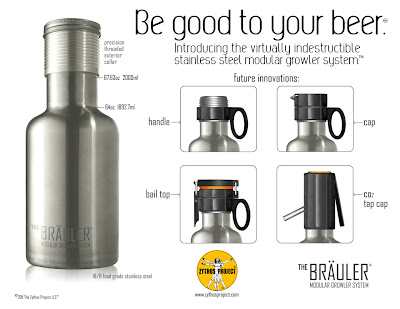The Growler Part II: The Present and Future
 |
| From kelliedayart.com |
This is the 2nd and final part of our series on the growler. Check out Part One on the history of the growler. This article focuses on the views of the growler's role in the modern day beer industry from some of the leading brewers and brewery CEO's including Greg Koch from Stone, Joe Morhfeld from Odell, Garrett Oliver from Brooklyn Brewing, and Matt Thrall from Avery. The article also looks at some of the present and future modifications companies are making to growlers to make sure the beers are fresh to consumers. So sit back, grab a growler, pour a pint, turn up the radio, and enjoy the read!
In short, [Oliver] thinks [growlers] suck
"A brewery will tell you to drink it within a day or two, but plans change. By the time you get around to actually drinking the beer, the chance that the growler will be anywhere close to as perfect as the brewer feels he was able to make it is pretty low."
I do agree that there are some valid points that are made from Garrett Oliver, who I do respect in the brewing community. Here are three points that I agree with:
Oxygen is not a friend of beer. There are multiple scientific articles addressing the oxidative reactions of beer. Yeast needs oxygen to live and convert starches to alcohol, but that's about the only good thing that oxygen does for beer. If you have ever opened a bottle of beer and thought "this beer tastes old or stale", that's probably due to oxidation. Heat and motion can accelerate these oxidative reactions too. Oxidative effects in light-colored beer can taste like cardboard or lipstick. Aroma usually decreases or disappears. That's why it's better to drink hoppy beers like IPAs and DIPAs when they are fresh to catch all the aromas the brewer intended to capture. Dark higher alcohol beers that are rich in malt aromas can be replaced by a sweet, cherry like aroma. This can be a nice change, but the malt flavor can decrease. Some beers will produce an unpleasant metallic flavor as they age.
So should the brewing industry just do away with the growler? What about the typical new brown growler fill at the local taproom? Is the beer too oxidized and light struck by the time it gets to your house to be enjoyable and not up to the breweries standards for their beer? I was skeptical these feeling were mutual by brewers across the board so I asked a few brewers their opinions.
Greg Koch, CEO and Co-Founder of Stone Brewing Co., states that there is no “bulletproof” container for storing beer whether that be a keg, bottle, or growler. Koch does, however, stand by their growler fills at the brewery. Each of their growlers has the date it was filled and a disclaimer stating that the beer should be drunk in less than 24 hours. If it’s not consumed by 24 hours, then it is out of Stone’s hands for freshness. Koch emphasized that growlers are not meant to be shipped which is a common beer trader practice. “You aren’t going to put Saran wrap on a glass of beer and ship it. Growlers are a little better than that but not by much.” Koch also states that they chose superior quality growlers to address some of the potential risks that the classic jug growler is more prone to. Their flip top growlers have thicker dark brown glass and a very good seal to retain carbonation. The stainless steel Kanteen is higher in price but is indestructible, has a great seal, and is impermeable to light.
Matt Thrall, head brewer at Avery Brewing, has a shorter view on growlers. Thrall states that as long as the beer is consumed within a very short time frame (a few hours tops) he has no problem with growlers. Otherwise, he takes Mr. Oliver's opinion that growlers equate to "putting a nice meal in a bag and then nuking it for lunch the next day."
After discussing growlers with multiple brewers and brewery owners, there seemed to be some common themes. For the most part growlers are a good option for beer drinkers IF the growler is clean and is consumed within a short period of time. The quicker the consumption, the fresher the beer and less risk for oxidation and sun-struck effects on the beer. Growlers are not meant to be consumed over a long period of time, and they should not be brought back dirty for a refill. I don't see growlers going away anytime soon, and some breweries are changing the look of the growler to address some of the negative factors that can affect fresh beer.
Most breweries use dark brown growlers to avoid direct sunlight exposure. Odell brewing still continues to use the clear growler. Mohrfeld states that is because it allows a quick visual of the cleanliness of the growler. "The potential for skunky beer is the downside but that can be easily remediable with an insulated growler jacket that they sell which keeps the growler cold and blocks out the light. Most people do not treat their growler all that well and the clear glass makes sure at least we are pouring beer into a clean vessel."
 Some breweries are using growlers with narrower necks and/or flip top porcelain caps with rubber seals. These growlers theoretically can keep the freshness of the beer longer. A narrower neck allows less oxygen mixing with the beer during a growler fill. The flip top caps could potentially make the growler more air-tight, prolonging the freshness of the beer prior to opening.
Some breweries are using growlers with narrower necks and/or flip top porcelain caps with rubber seals. These growlers theoretically can keep the freshness of the beer longer. A narrower neck allows less oxygen mixing with the beer during a growler fill. The flip top caps could potentially make the growler more air-tight, prolonging the freshness of the beer prior to opening.Stainless steel growlers are also slowly making their way to the beer scene. Stone brewing sells a 40oz. Kanteen made by Klean Kanteen makers of stainless steel water bottles and cups. Bonfire Brewing, a new brewery in Eagle, CO, uses a stainless steel 64oz. container from Hydroflask. The manufacturer states that "it keeps cold cold for 24 hrs". Bonfire was looking for a vessel that could withstand activities such as boating, hiking, biking, and camping that a glass growler could not and could accommodate fills and refills. They like the stainless steel option because it lasts longer, is easier to clean, has uses other than beer, and is 100% recyclable.
Other companies are in the works to unveil their versions of growlers. The Zythos Project, a Portland, OR, company is in the works for 2012 to release the Brauler, a 64oz. stainless steel vessel that is described as a modular growler system. It is being designed to accommodate multiple cap options and accessories including a CO2 cartridge charged tap-cap which will allow users to dispense beer under top pressure through a tap and even gently and safely recharge flat beer. They state that their stainless steel growler will be superior to other similar types because of a highly engineered thread/cap system that effectively contains pressure that others don't because they've come from the water bottle world. Plus it has a very wide neck for easy cleaning and seeing into the vessel.
The growler has helped US beer lovers, in one form or another, enjoy portable beer for over 150 years. The growler is by no means a perfect vessel, but it can provide us with a unique beer experience if we handle the growler with care and consume the beer in a short period of time. I agree with Greg Koch that growler fills at beer bars, convenience stores, and grocery stores would be a smart environmental paradigm shift, and I hope laws are changed in states where this form of service is illegal. Just coming back from a trip to Seattle and seeing the popularity of growler fills at beer bars like The Uber Tavern, I can see how this practice could provide another stepping stone for the promotion of craft beer and be a benefit to the environment. I for one am glad the growler is here and am excited to see how it evolves along with the increased appreciation for craft beer.






